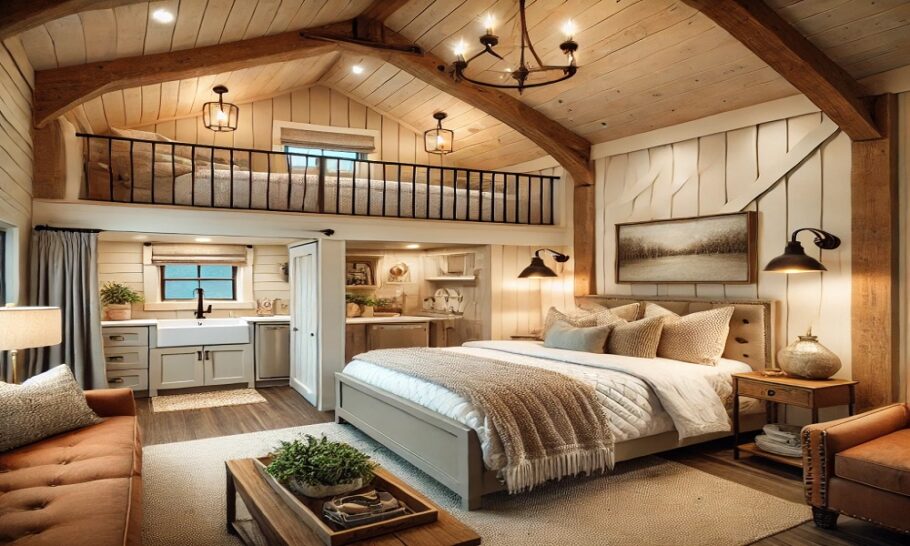Barndominiums have taken the architectural world by storm—blending the rustic charm of barn-inspired structures with the comfort and modern functionality of residential living. As more homeowners embrace the barndo lifestyle, one key element often overlooked during the initial planning stages is lighting design. Lighting in a barndominium isn’t just about visibility; it’s about enhancing the ambiance, emphasizing architectural features, and aligning the home’s aesthetics with its functional needs.
In this post, we’ll dive deep into barndominium lighting design, including planning tips, fixture types, layered lighting techniques, energy considerations, and how to blend rustic and modern elements to create a cohesive and beautiful living space.
Why Lighting Design Matters in a Barndominium
Barndominiums are unique in structure. Their wide, open layouts, soaring ceilings, and industrial roots offer both opportunities and challenges when it comes to lighting.
Here’s why a thoughtful lighting plan is crucial:
- Open floor plans require strategic lighting zones.
- Tall ceilings need fixtures that scale with volume.
- Rustic-modern aesthetics demand a careful balance of materials and light temperatures.
- Multifunctional spaces (kitchen/living/dining combos) need flexible lighting solutions.
Done right, lighting will make your barndominium feel warm, inviting, and well-composed—whether you’re reading a book, cooking dinner, or entertaining guests.
Start with a Lighting Plan
Just like plumbing or HVAC, lighting should be planned before construction or renovation. Consider these steps:
- Assess Natural Light
Evaluate how much daylight each area receives. Barndominiums often have large windows and even clerestory elements, allowing sunlight to flood in. The goal is to supplement (not fight) natural light during the day and provide sufficient artificial light at night.
- Define Activity Zones
Barndominiums typically have open spaces that serve multiple functions. Break them down into zones like:
- Kitchen/prep area
- Dining area
- Lounge/living area
- Loft or second floor
- Entryway or mudroom
- Utility/storage/workshop areas
Each zone will have unique lighting needs.
- Choose a Layered Lighting Approach
Rather than relying on a single overhead fixture, use layered lighting to build depth and functionality. The three layers are:
- Ambient – General lighting to fill the space.
- Task – Focused lighting for specific activities (cooking, reading, etc.).
- Accent – Decorative or architectural lighting to highlight features.
Fixture Types Ideal for Barndominiums
The right fixtures will reflect both the style and function of your home. Here are popular types to consider:
- Chandeliers & Pendants
Perfect for high-ceiling spaces and open living areas, chandeliers and oversized pendants make a bold visual statement. Opt for materials like black iron, galvanized steel, wood, or mixed metals to echo the industrial-barn vibe.
Best used in:
- Entryways
- Dining areas
- Over kitchen islands
- Living rooms with vaulted ceilings
- Track & Rail Lighting
These flexible systems allow you to direct light where it’s needed. Ideal for showcasing art, illuminating beams, or adjusting to changing room functions.
Best used in:
- Hallways
- Loft spaces
- Work areas
3. Recessed Lighting (Can Lights)
These provide clean, unobtrusive general lighting and are essential for ambient lighting in barndos with exposed trusses or low ceilings in certain rooms.
Best used in:
- Kitchens
- Bathrooms
- Utility areas
- Wall Sconces
Add layers and warmth without taking up floor or ceiling space. Choose lantern-inspired styles for a farmhouse feel or minimalist sconces for a more modern touch.
Best used in:
- Hallways
- Bathrooms
- Beside beds or mirrors
- Floor & Table Lamps
Great for flexibility and atmosphere. Mix and match wood and metal lamp bases with linen or jute shades to keep the rustic-modern balance.
Best used in:
- Living areas
- Bedrooms
- Reading nooks
- Industrial Fixtures
Caged lighting, gooseneck sconces, and warehouse-style fixtures pair perfectly with a barndo’s metal siding and exposed beams.
Light Temperature & Bulb Choice
Don’t overlook the importance of color temperature and bulb type. These can dramatically impact mood and energy efficiency.
Color Temperature
- Warm White (2700K–3000K): Cozy and ideal for living rooms and bedrooms.
- Neutral White (3500K–4100K): Bright without being harsh, great for kitchens and bathrooms.
- Cool White (5000K+): Crisp, ideal for task-heavy areas or workshops.
Stick to one consistent temperature per space or per zone to avoid visual conflict.
Bulb Type
- LEDs: Energy-efficient, long-lasting, and available in all color temperatures.
- Smart Bulbs: Allow remote dimming and color adjustments.
- Edison-style LEDs: Perfect for vintage looks with modern efficiency.
Rustic Meets Modern: Styling Your Fixtures
Barndominiums often sit at the intersection of old and new, and lighting is a perfect opportunity to express this fusion.
Rustic Design Tips:
- Use wood and wrought iron for a weathered, grounded feel.
- Include lantern-style sconces or pulley-based pendants.
- Add warm, dimmable bulbs to soften the industrial edges.
Modern Design Tips:
- Opt for matte black or brass finishes.
- Choose geometric or minimalist silhouettes.
- Use track lighting for flexibility and clean lines.
You can also mix elements—e.g., pair a reclaimed wood chandelier with matte black pendants to create harmony between farmhouse and industrial themes.
Lighting Tips for Specific Barndominium Spaces
Kitchen
- Layered approach: recessed cans + pendant lights over islands + under-cabinet task lighting.
- Focus on brightness and shadow control.
- Consider dimmers for evening ambiance.
Living Room
- Use chandeliers or large pendants for drama.
- Add floor lamps near seating.
- Accent walls or fireplaces with directional lighting.
Bedrooms
- Wall sconces or pendant lights beside the bed free up nightstand space.
- Use warm temperatures for comfort.
- Add a ceiling fan/light combo for multifunctional use.
Bathroom
- Task lighting at mirrors is key (flank with sconces or lighted mirrors).
- Add recessed cans for general light.
- Don’t forget ventilation if using combined fan/lights.
Loft/Office
- Flexible task lighting is critical.
- Consider articulating desk lamps or clamp lights.
- Use daylight bulbs to reduce eye strain.
Exterior
- Barn-style gooseneck lights enhance the structure’s character.
- Use motion sensors for utility lighting.
- Consider solar-powered fixtures along paths and driveways.
Energy Efficiency and Smart Controls
Modern barndominiums often incorporate sustainable design features. Lighting can be part of that effort:
Tips for Efficiency:
- Install dimmers and motion sensors to avoid wasted energy.
- Use LEDs across all fixture types.
- Use solar-powered outdoor lighting.
- Design spaces to maximize natural light, reducing daytime use of fixtures.
Smart Lighting Ideas:
- Use smart bulbs (like Philips Hue or LIFX) for remote control and scheduling.
- Install voice-controlled switches via Alexa, Google, or Apple HomeKit.
- Set scenes for different moods: “Morning,” “Dinner,” “Movie Night,” etc.
Final Thoughts
Lighting in a barndominium is far more than a practical necessity—it’s a design tool that shapes mood, defines space, and complements the structure’s distinct character. Whether your barndo leans rustic, modern, or somewhere in between, a well-executed lighting plan brings cohesion, comfort, and visual intrigue to every corner of your home.

